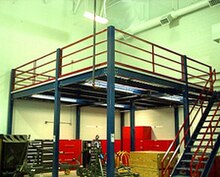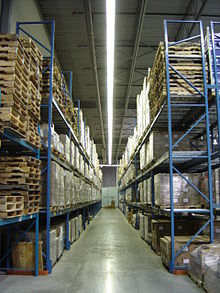Material-handling equipment
This article needs additional citations for verification. (August 2013) |





Material-handling equipment is equipment that relate to the movement, storage, control and protection of materials, goods and products throughout the process of manufacturing, distribution, consumption and disposal. Material handling equipment is the mechanical equipment involved in the complete system.[1]
Material handling equipment is generally separated into four main categories: storage and handling equipment, engineered systems, industrial trucks, and bulk material handling.
Material handling and efficiency
Material handling equipment is used to increase output, control costs, and maximize productivity. There are several ways to determine if the material-handling equipment is achieving peak efficiency. These include capturing all relevant data related to the warehouse’s operation, measuring how many times an item is “touched” from the time it is ordered until it leaves the building, making sure you are using the proper picking technology, and keeping system downtime to a minimum. A special analytical data-set known as Stock-keeping units (SKUs) has been devised to aid analysis of materials handling, which is obviously less efficient when a material asset is handled any more than a minimally necessary number of times.
Types of material-handling equipment
Storage and handling equipment
Storage and handling equipment is a category within the material-handling industry. The equipment that falls under this description is usually non-automated storage equipment. Products such as pallet racking, shelving and carts, among others, belong to storage and handling. Many of these products are often referred to as "catalog" items because they generally have globally accepted standards and are often sold as stock materials out of Material handling catalogs.
Engineered systems
Engineered systems are typically custom engineered material-handling systems. Conveyors, Handling Robots, AS/RS, AGV and most other automated material-handling systems fall into this category. Engineered systems are often a combination of products integrated to one system. Many distribution centers will optimize storage and picking by utilizing engineered systems such as pick modules and sortation systems.
Equipment and utensils used for processing or otherwise handling edible product or ingredients must be of such material and construction to facilitate thorough cleaning and to ensure that their use will not cause the adulteration of product during processing, handling, or storage. Equipment and utensils must be maintained in sanitary condition so as not to adulterate or contaminate product.
Industrial trucks
Industrial trucks usually refer to operator driven motorized warehouse vehicles, powered manually, by gasoline, propane or electrically.[2] Industrial trucks assist the material-handling system with versatility; they can go where engineered systems cannot. Forklift trucks are the most common example of industrial trucks but certainly aren't the extent of the category. Tow tractors and stock chasers are additional examples of industrial trucks. Their greatest advantage lies in the wide range of attachments available; these increase the truck ability to handle various types and shapes of material.
Bulk material handling
Bulk material-handling equipment is used to move and store bulk materials such as ore, liquids, and cereals. This equipment is often seen on farms, mines, shipyards and refineries. This category is also explained in Bulk material handling.
On-rails transfer cart
On-rails transfer cart is a kind of material-handling equipment. It moves on the rails and can transfer heavy cargoes or equipment with the weight 1-300t between the workshops or warehouses in the factory. It is widely used in the line of metallurgy, coal, heavy manufacturing, automotive assembly, etc. Its power can be AC or DC. DC Power has rail transmit power and battery power, while AC power includes cable power and slippery touch line power. In addition, there is the manual rail transfer cart or towed rail transfer cart, also called motorized transfer trolley.
Conveyors
Conveyors are another form of material handling. Conveyors can be used in a multitude of ways from warehouses to airport baggage handling systems. Some types of conveyors are unibilt, power and free, chain, towline and roller conveyor.
Cantilevered crane loading platform
Cantilevered crane loading platforms are temporary platforms attached to the face of multi-storey buildings or structures to allow materials and equipment to be directly loaded on or shifted off floor levels by cranes during construction or demolition. They may be fixed or rolling and a variety of designs are used including fully fabricated and demountable types. The platforms are supported on needles (cantilevered beams) anchored to the supporting structure.
See also
- Pallet
- Forklift truck
- Conveyor belt
- Automated storage and retrieval system
- Carton flow
- Mezzanine (architecture)
- Logistics automation
- Electric tug
References
- ^ "Glossary". Mhi.org. Retrieved 2013-08-19.
- ^ "Glossary". Mhi.org. Retrieved 2013-08-19.
